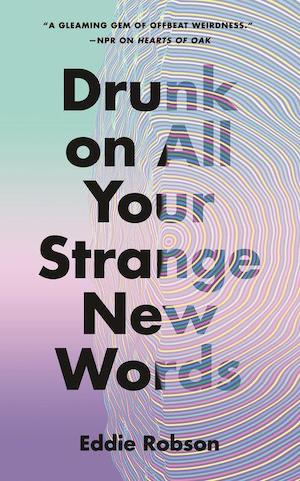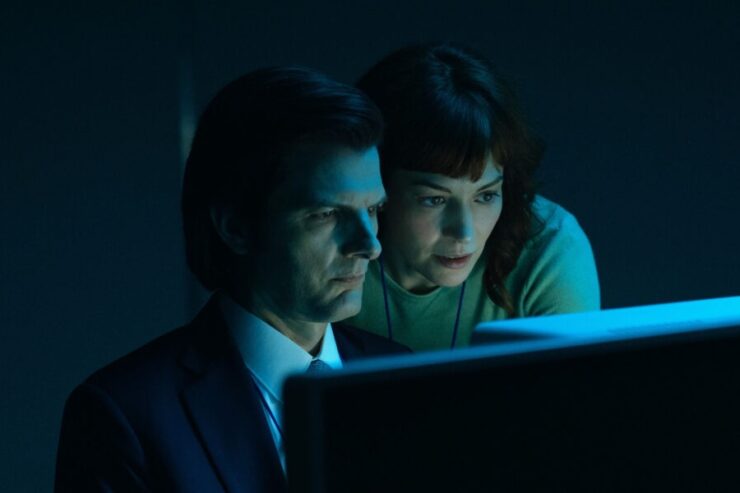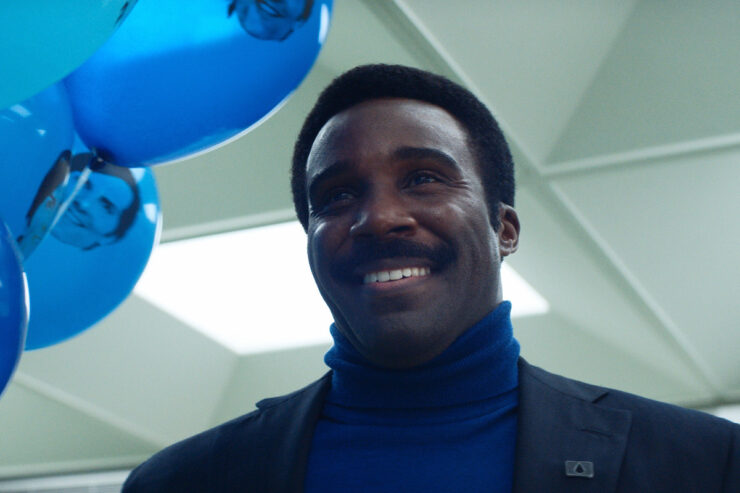As the series Severance unfolded over nine weeks, viewers were treated to one of the smartest, most thoughtful sci-fi satires on TV… a satire rife with the hallmarks of a good Philip K. Dick story. While built on the same foundation of mystery box TV shows like LOST, Severance works on several levels and themes that PKD would have enjoyed—because they are ones he explored over several decades of writing.
[This article contains spoilers for the entire first season of Severance.]
Severance is a dark satire of corporate life starring Adam Scott as Mark S, an office worker at Lumon Industries. What they do or make at Lumon remains a mystery for the employees in Macrodata Refinement, a department in Lumon Industries that undergo an experimental procedure called Severance. A chip in their brains divides their lives and memories of work and home into separate realities. Once Mark and his co-workers Dylan, Irving, and Helly enter the elevator, the switch happens. The “innies” and “outies” have no knowledge of each other. The building is underground, and the hallways recall Kubrick movie sets as long bright white mazes.
Early in the show, our point of view is Mark; he is the only member of the team who we see in both lives. Mark is curious about what happened to Petey, his co-worker whom Helena (Britt Lower) replaced. As outside Mark dives into this mystery, his inside-self at work is still in the dark. The other two members of their cubicle team, Irving (John Turturro) and Dylan (Mark Cherry), don’t question the idea of the Severance procedure. Irving is a corporate lifer who knows the employee handbook like gospel and seems to worship company founder Keir Egan, while Dylan is completely wrapped up in earning corporate perks—trinkets such as finger traps and erasers for his performance on the job, all building to the ultimate prize: the always-out-of-reach Waffle Party.
While creator Dan Erickson has pointed to Kurt Vonnegut as an influence, and not PKD, I thought it would be fun to look at all the themes of the show and how Philip K. Dick explored them. Hollywood tends to adapt PKD’s novels and stories into paranoid thrillers, but his prose is often underrated for its sly humor and darkly thematic satire.
Memory Manipulation
The altering of memory is something Philip K. Dick explored in three stories published in 1953, his most prolific year for short fiction. All three stories—“We Can Remember It for You Wholesale,” “Paycheck,” and “Imposter”—were made into films, including the Arnold Swarzenegger classic Total Recall.
Buy the Book


Drunk on All Your Strange New Words
Both “Paycheck” and “We Can Remember It for You Wholesale” are stories about erased memories. But it was “Paycheck” that explored this radical form of biological or surgical non-disclosure agreement; the central character Jennings is an engineer who agrees to have two years of his life working on a top-secret project erased. While it is only a ten-page story, a few similarities to Severance are there—Jennings is shocked to discover he waived his pay for an envelope filled with random items, and the intentions of the corporation and the nature of the work they do remain a mystery to Jennings until the trinkets save his life and lead him to clues about his invention.
While not as closely related, “We Can Remember it for You Wholesale” is a story about a company that sells memories of vacations you never had, which they sell as better than unreliable natural memories. The story takes off when Douglas Quail (Quaid in the movie) has a reaction to the procedure and his nature as a secret agent (maybe?) is revealed. At the time of release, Total Recall was one of the most expensive films ever made, so it is probably the most famous story of memory manipulation—much like Severance, Quail’s work life was kept secret from him.
Work-Life Balance
At the heart of Severance is a scathing satire of work-life balance. It comes at a time when much of the world is rejecting office life for working at home, in what has been labeled by Professor Anthony Klotz as “the Great Resignation.” When the show starts, Mark S has agreed to Severance because he is grieving for his wife who died in an accident, something Innie Mark knows nothing about. This life lived entirely at work is accepted by the team until Helly (the new woman in the office) rejects her new situation, tries to escape, and even attempts suicide.
While Philip K. Dick didn’t address cubicle life in the office, his characters were often working class, in sharp contrast to the scientists and military leaders in most space operas. His characters had jobs as repairmen, regrooving tires, or fixing pots. Additionally, PKD works are peppered with moments when technology is used to assist with maintaining worker control, from the Dr. Smile therapy briefcase in the Three Stigmata of Palmer Eldritch (1964) to Juveniles, an omnipresent Camera system in The Man Who Japed (1956).
In Severance, the chip creates a home/work separation that becomes a technologically induced form of Schizophrenia, a theme PKD explored in his novel A Scanner Darkly (1977) where an undercover cop uses a drug called Substance-D, separating his brain into two halves and spying on himself. In A Maze of Death (1970) a group of colonists believe they have landed on Delmak-O, a planet ruled by jelly-like beings who claim to be gods. While the setting is far more spaced-out and pulpy, it shares similar themes with Severance: The colonists are corporate tools that travel in one-way rockets, with no idea where they are going. As they explore the planet, they begin to suspect they are insane, in a simulation, or a part of an experiment.
In The Three Stigmata of Palmer Eldritch, Barney Mayerson works for a corporation that makes drug-induced simulations that can be used for working or escape. They become essential for life in the barely habitable Mars colonies, where their drug Can-D creates a Barbie Doll-like reality called Perky Pat. I couldn’t help thinking about this as the characters living underground in Severance work hard for the illusion of reward perks.
In The Penultimate Truth (1964), humanity has moved underground while robots fighting on behalf of the major superpowers continue to war. Afraid of radiation, it has been some time since many humans dared go to the surface. They stay underground, inspired by the speeches from their leader, Tom Yancy, who is actually computer-generated. All this is manufactured to keep the workers making “leadies,” the robots who fight the war. This carefully manufactured fiction to maintain the workforce underground is certainly further into the field of science fiction, but was in my mind more than once while watching the show. It is likely that PKD would have greatly related to the satire of office work and the idea of subtle attempts at control.
Who am I working for and why?
When Irving (John Turturro) quotes from the employee handbook, or speaks of their corporate founder, he sounds like a member of a cult. Certainly, when Corporate Management Ms.Corbel (Patricia Arquette) and Milchick (Tramell Tilman) speak of Lumon Industries there is a religious quality.
In many novels, PKD explored the idea of fake or simulated leaders who were used to manipulate or control workers or entire populations, Sometimes those leaders were governmental, at times they were corporate. Sometimes they were real officials like in The World Jones Made (1956) or The Man Who Japed, but often they were manufactured as in The Penultimate Truth or The Simulacra (1964). In Three Stigmata of Palmer Eldritch, the villain was both cybernetic and a chemical reaction to drugs. In the novel The Game Players of Titan (1964), a similar thing plays out as silicon-based aliens from Titan play a game called Bluff that is used to control land on post-war earth. There is a feeling that the Vugs from Titan control their lives and humans on earth are simply pawns. In The Zap Gun (1967) Lars Powderdry of Mr. Lars Incorporated designs weapons during a cold war in which both sides have decided to simulate war. Lars is sad to learn none of his “weapons” are functional, having become fashion items only displayed in war simulations.
As the Lumon employees tried to figure out exactly what they were doing, I thought of PKD’s first hardcover novel Time Out of Joint (1959). Long before The Truman Show, this novel was about an entire community that was designed to make one man, Ragle Gumm, believe it is 1959. In the novel, it is really 1998 and the earth is at war with moon colonists. While Gumm believes he is solving puzzles printed in the newspaper, he is really calculating war plans. The Innies are just as in the dark as Ragle Gumm, and they could be waging war or making toys.
Irving is devout to the gospel of Lumon, as shown by his adherence to the handbook and his awe at seeing things like the paintings of Kier Egan displayed in certain areas of the building. Cult-like leadership is a theme returned to often in PKD novels like the FedGov dictator in The World Jones Made, who rose to power because he could see the future, or Palmer Eldritch, who used the drug Chew-Z to enter the minds of suffering Mars colonists.
That idol worship is showcased in two pivotal moments during Severance. When the Macrodata team completes their project in record time, they are rewarded with a waffle party (for one) that they send Dylan to. When he arrives, he is given a mask of CEO Kier Egan to wear, while masked dancers perform for him. He is given a chance to lay down in the museum representation of the leader’s bed—so the workers rewarded with waffle parties get to experience what it’s like to be their leader.
When Helly is revealed to be the CEO’s daughter, and the audience learns that her intention was to be a spokesperson for the Severance process, there is a chilling moment that reminded me of PKD’s villain in the Three Stigmata of Palmer Eldritch, whose invasion is of the mind itself. Kier tells her about the first time she saw the Severance chip: “You said it is beautiful. Everyone in the world should get one, they will all be Kier’s children.” It is speculation on the future seasons, but it seems the mission of Lumon is a chip in everyone’s brains. Yeah, that is a theme very much in Philip K. Dick’s vein.
Personal or Alternate Reality
There is a reason to believe that the events of Severance take place in an alternate reality or a micro-reality—something we refer to as a personal cosmos story on the Dickheads podcast. The biggest clue that points to this theory can be found in the license plates on the cars. They are not for any state, but have an image of Keir Egan and the Latin phrase “Remedium Hominibus,” which basically means “cure for humanity.”At no time is the location of Lumon given, and there are actually no indications that the story takes in our reality… except in an interview where Helena says she was born in Delaware. This seems intentional, as Delaware is the state for cheap incorporation, for tax reasons.
Is Severance a simulation? I think the events of the final episode discount this theory, specifically Mrs. Cobel and her relationship with Mark in both worlds. But it is possible that the whole thing is a simulation.
Micro-reality or personal cosmos concepts is an idea that PKD explored several times: While simulation theory movies seem pretty common in science fiction post-The Matrix, Dick explored the concept for the first time in his groundbreaking novel Eye in The Sky (1957). He returned to the concept in The Three Stigmata of Palmer Eldritch, A Maze of Death, and most famously in his classic novel Ubik (1969)
It is also likely that Severance simply takes place in an alternate reality. It’s a common trope in science fiction now, but PKD won his one and only Hugo award for The Man In the High Castle (1962). He explored the concept of alternate realities in other novels such as Dr. Futurity (1960), Counter-Clock World (1967), and most effectively in Flow My Tears the Policeman Said (1972).
If the events in Severance are not a simulation, then the characters are left to wrestle with one of the questions that PKD dealt with so often that it is almost impossible to pin down.
Who is the real me?
After Helly attempts to escape Lumon several times, her outie tapes her a video message and puts it bluntly: “I am a person, you are not.” The crack in Dylan’s acceptance of his work-life is finding out for a brief moment that his outie has a child. For Irving, it is his feelings for Burt (Christopher Walken), who retires just as they explore their feelings for each other. For Mark S, it is reading the self-help book left in his desk. The Macrodata team decides to rebel when, one by one, they realize that they are not people. This, of course, is why in the era of the so-called Great resignation, Severance is a show that so many in the workforce relate to. And personhood is the theme of PKD’s most famous work…
It is because of the film Blade Runner that the PKD novel Do Androids Dream of Electric Sheep? (1966) has never left print. The story of a bounty hunter who hunts down Androids posing as humans is much deeper on the themes of authenticity than the film. In the novel, people show off their wealth by collecting nearly extinct animals, to the point that there is a market for fake animals. At several points in the story, Deckard is called upon to test the humanity of individuals and uses a test that measures empathy. This is ironic, as some of the most popular technologies in the book are mood organs and empathy boxes, where people can order emotions like take-out. By the end, Deckard, the man sent to retire Androids, worries that he might be one himself.
Theories Moving Forward…
The second season of Severance has been confirmed, which is great because the first season ended with a mind-bending twist: Ms. Casey, the woman who worked at Lumon and observed workers, is in fact Mark’s supposedly dead wife.
There are clues that Ms. Casey is not alive in a traditional sense. Her behavior is robotic, as if she is not quite sure how to behave, and she can count the hours she remembers being alive. Unlike other Severed employees, she has no outer life. She is scared to go down a dark hallway into blackness. While the reasons remain a mystery, the most plausible theory is that Gemma is either brain-dead or re-animated. If she is brain-dead then it would explain why Lumon would be re-building her mind, and it would explain Ms. Corbel’s interest in Mark. In the first episode, it is said that the numbers the team are crunching represent emotions. So perhaps they are rebuilding the minds of the dead or brain-dead.
PKD addressed re-animation in his hilariously surreal novel Counter-clock World, set in a universe where time goes backward, and this final reveal highlights one of PKD’s most darkly funny novels, Ubik. Also a corporate satire, Ubik is about Joe Chip who works for Runciter Associates, an agency “prudence organization” that reveals or negates corporate competitors who use psychic abilities. After a businessman hires them to protect their facility on the moon, Joe and his eleven co-workers are witnesses to a bomb blast. Time starts moving in the wrong direction and they begin to see their bosses’ face on products everywhere. Eventually, they learn that they are dead, and their minds are being kept alive in “half-life,” where they are being advertised a magic product that seems to do anything and everything… called Ubik.
Is Mark’s wife being kept alive in half-life? Only a second season will tell us. What we do know is, intentionally or not, the first was filled with Philip K. Dick themes and concepts. I have spent the last five years diving deeply into the work of Dick, and hope that the popularity of Severance might lead some viewers looking for a similar experience in mind-bending fiction to give him a shot.
David Agranoff is a novelist, screenwriter, and a Horror and Science Fiction critic. He is the Splatterpunk and Wonderland book award-nominated author of 8 books including the novels the Cli-fi novel Ring of Fire, Punk Rock Ghost Story, and Goddamn Killing Machines which he describes as The Dirty Dozen meets PKD. As a critic he has written more than 1,100 book reviews on his blog Postcards from a Dying World which has recently become a podcast, featuring interviews with award-winning and bestselling authors such as Stephen Graham Jones, Paul Tremblay, Alma Katsu, and Josh Malerman. For the last three years, David has co-hosted the Dickheads podcast, a deep dive into the work of Philip K. Dick reviewing his novels in publication order as well as the history of Science Fiction. His novels are available on Amazon or Bookshop.org. You can follow David on Twitter @DAgranoffauthor. For more detailed discussions on the work of Philip K. Dick: Now Dickheads is on Apple podcasts as PKDheads.















Interesting and thought provoking article about an intriguing show.
One correction, however: “We Can Remember It For You Wholesale” first appeared in the April 1966 issue of The Magazine of Fantasy and Science Fiction. (I have that issue and indeed my last reread of the story was in that issue.)
Sorry that was my bad.
After Helly attempts to escape Lumen several times, her outie tapes her a video message and puts it bluntly: “I am a person, you are not.”
I’d been enjoying Severance up to this point in the show, but when her outie says this I was completely hooked. From that point on I viewed each episode from a slightly different perspective. I think it’s one of the most intriguing explorations of personhood that I’ve seen.
As to whether it takes place in a simulation, I can’t help but think that knowing that (or even guessing it) would have crushed the suspense that mounts masterfully towards the end of the season. In addition to the mention of Delaware, I seem to remember that towards the end of Mark’s disastrous first date with Alexa (okay, there’s a simulation hint maybe!), he gets the name of her home state (Montana) wrong (Minnesota). Not that simulations shouldn’t have real state names. Anyway, I very much hope that this doesn’t turn out to be some kind of simulation. Emily St John Mandel’s recent novel was partly spoiled for me by the rather redundant notion that everything in it might be a simulation and I’d hate the same to happen Severance.
Yeah Jasmine I don’t think it is a simulation but I had to address the theory, In an article about PKD especially. ha-ha. Thanks for reading and commenting.
If you really want to further explore PKD my recommendation would be to read the entire “Valis” trilogy, then read PKD’S “Exegesis”.
Thanks for crediting the term “The Great Resignation.” Terms creep into our language but we seldom know where or who they come from. My brain is not nimble enough to understand PKD’s work. While Blade Runner remains my #1 all-time favorite movie, I know I’d get tripped up trying to read the book. If I happen upon Severance, I’ll need this article. It seems you have a near-exhaustive knowledge of PKD’s work, and I can tell you love it.
The thing about A Maze of Death is that once they come out of the simulation onboard the ship and the reader thinks they are “grounded” (if also despairingly so), you have the question of what happened to Seth Morley? (I’m not sure how I feel about multi-layered virtual realities … it’s like time travel stories with too many loops.) FTR, it’s a great novel to teach, and I like to follow it with a viewing of The Forbin Project.
Many people confuse schizophrenia with dissociative identity disorder (colloquially multiple personality disorder.) The two have some common symptoms, but Severance deals more with a drug-induced DID rather than schizophrenia.
I’m probably wrong, but in my opinion the simulation is a physical reality at the Lumon headquarters.
The purpose of which is to test Lumon’s *product*, the Severance process/chip itself.
I never met Philip Dick.
I did know people who had.
One told me, “You could call him at three in the morning. To complain about your love life. He wasn’t offended, he listened. He was just a lovely man.
“But it’s a good thing he could write. He was too crazy to earn a living in any normal job.”
Nice piece, David. If you’d like me to gift you an ebook copy of my book “Philip K. Dick: The Dream Connection,” just drop me an email.
One element of Severance I couldn’t resolve is why it’s set in the 1990s. It’s all 1990s designs and technologies, except for one element – the severance chip itself – which seems to be from the future. I can think of several maybes – e.g. it’s a simulation being run in the 1990s, incorporating current things from the real world of the time – but they all seem a bit weak.
“At no time is the location of Lumon given”. Would have to go back and look but I’m pretty sure at one point you see a sign that says that they are in Allentown, which I assumed was the old steel town (cue Billy Joel) and an indication that Lumon was preying on a place where options were few.
Excellent article, I have many PKD titles now lined up for rereads.